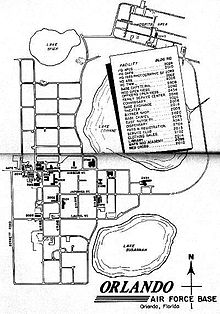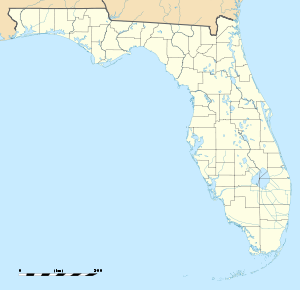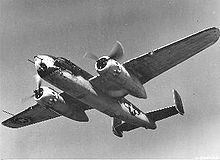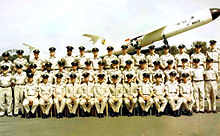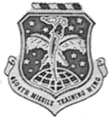- Orlando Air Force Base
-
Orlando Air Force Base Part of Military Air Transport Service (MATS)
Military Airlift Command (MAC)
Tactical Air Command (TAC)Orlando, Florida 
Front gate of Orlando AFB, about 1958Coordinates 28°34′3.40″N 81°19′50.13″W / 28.567611°N 81.3305917°W Built 1940 Built by United States Air Force In use 1940-1967 Open to
the publicYes Controlled by  United States Air Force
United States Air ForceGarrison Orlando, Florida Occupants Army Air Forces School of Applied Tactics
1306th Air Base Group
Air Rescue Service
4504th Missile Training WingBattles/wars World War II
Korean War
Vietnam War
Cold War- For the Strategic Air Command (SAC) base in Orlando, see McCoy Air Force Base
Orlando Air Force Base is a closed United States Air Force facility, located in Orlando, Florida. It was established in 1940 as a World War II training base and was also used for coastal patrols during World War II.
The base was located just north of Florida Highway 50, directly north of the Orlando Executive Airport. Access through the main gate was on Corrine Drive at the intersection with Bennett Drive. An additional gate was located in the northeast corner of the base on Lakemont Avenue and provided access to the cantonment area containing USAF Hospital Orlando, as well as access to and from the adjacent city of Winter Park. Orlando AFB was located approximately eight miles north of McCoy Air Force Base, a second USAF installation also located in Orlando.
Orlando AFB was inactivated as an Air Force installation on 31 December 1967 and jurisdiction was transferred to the United States Navy effective
1 Janunary 1968, although the last USAF unit was not inactivated on the station until June 1970.The installation was renamed by the Navy as Naval Training Center Orlando and conducted enlisted recruit training, selected enlisted technical school training, and nuclear power training for both officers and enlisted personnel until 1999, when it was closed per a 1993 Base Realignment and Closure (BRAC) Commission decision.
Contents
History
World War II
Originally named Orlando Army Air Base, the installation was created when the first United States Army truck convoy rolled into this central Florida community in August 1940 to take over the existing Orlando Municipal Airport. A vast construction program was subsequently begun at the airport, extending to the north and west of the original airfield. Orlando Army Air Base was officially opened on 1 December 1940 and became the Interceptor Command School of the United States Army Air Corps (later United States Army Air Forces). During the next two years, additional land was obtained and multiple auxiliary landing fields were built throughout Central Florida to the north, south and west of the base. Nearly all these auxiliary fields continue in use today as civilian airports.
Base Units:
- 906th Army Air Forces Base Unit (Bombardment, Heavy), activated 1 March 1944
- 906th Base Bombardment Group (Redesignated from 1164th School Squadron)
- 905th Army Air Forces Base Unit (Bombardment, Heavy), activated 1 April 1944
- 901st Army Air Forces Base Unit, activated 1 June 1944
Army Air Forces School of Applied Tactics
Operations through the war years, beginning in November 1942, were centered around what became the Army Air Forces School of Applied Tactics (AAFSAT) in October 1943.[1] Headquartered at Orlando AAB, AAFSAT's function was to train cadres from newly-formed units in combat operations under simulated field conditions as the cores around which new combat groups would be formed.
In addition to its training function, the school also developed as a tactical doctrine development center, assuming the functions formerly assigned to the Air Corps Tactical School (ACTS). In this function, it also became known as the Army Air Forces Tactical Center (AAFTAC).
During 1943-1945, AAFSAT operated a combat simulation facility in Florida. Units and airfields were established throughout an 8,000-square-mile (21,000 km2) area of north central Florida designated a mock "war theater," stretching roughly from Tampa to Titusville and from Starke to Apalachicola in which war games were conducted using numerous military airfields. AAFSAT also had a bombing range at Ocala Army Airfield, a service center at Leesburg Army Airfield, and an air depot at Pinecastle Army Airfield.
Known Assigned Units to Orlando AAB were:
- 5th Bombardment Squadron (15 April 1943 – 7 January 1944; 13 February – 7 March 1944)
- 735th Bombardment Squadron (Elements of deployed B-24 Liberators from Pocatello Army Air Base, Idaho between 29 July - 29 September 1943 flying simulated combat missions at AAFSAT)
- 466th Bombardment Group (Elements of group deployed B-24 Liberators from Kearns AAB, Kearns, Utah between 1–31 October 1943, flying simulated combat missions at AAFSAT)
- 382d Bombardment Group (Elements of group deployed from Smoky Hill AAF, Kansas between 1–30 November 1944 for training in B-29 Maintenance. It also flew some B-17 simulated combat missions at AAFSAT).
Night Fighter Training
Night fighter combat over the skies of England made the USAAF aware of the need for night air defense training and tactics development. The Third Air Force was ordered to develop a training program to produce pilots with night fighting skills in early 1942. An Air Defense Operational Training Unit was established on 26 March. A few days later this was renamed the Interceptor Command School. One of the units assigned to the school was the 50th Pursuit Group (Interceptor), later renamed the 50th Fighter Group (50th FG).
While the 10th and 313th remained as pursuit fighter training squadrons with P-40 Warhawks, the 81st was given the responsibilities of night fighter training operations. In July 1942, the 81st received one B-18 Bolo and a number of modified Douglas A-20 Havocs for night fighter operations, designated P-70s. By the end of September, the Army Air Forces School of Applied Tactics' (AAFSAT) Night Fighter Department (Dark) was activated and the 81st Fighter Squadron was detached from the 50th FG and placed directly under the Department for training and operations. About 20 pilots were in the first class.
In October 1942, the personnel and equipment of the 81st were reassigned to the newly-formed 348th and 349th Night Fighter Squadrons, and returned to operational control of the 50th Fighter Group. The 50th FG remained a training squadron at AAFSAT until early 1944.
The Night Fighter Department's immediate requirement was to train night fighter pilots for two operational squadrons that were destined for Hawaii and one for Panama. However the training program could not initially be carried out due to a lack of training aircraft. The first two classes graduated in December 1942 with only 80% of the planned flight training due to a lack of equipment, all of the pilots would be assigned to the 6th Night Fighter Squadron in Hawaii.
In early January 1943 the 349th NFS was moved to Kissimmee Army Airfield, Florida, where night fighter training would be conducted, leaving Orlando AAB to form and equip the squadrons, although some night fighter training remained at Orlando AAB.
Known Night Fighter squadrons formed/trained at Orlando AAB were:
- 414th Night Fighter Squadron, Formed Jan-Feb 1943, trained at Kissimmee AAF
- 415th Night Fighter Squadron, trained Feb-April 1943
- These two squadrons only received about two months training in Florida before being assigned to the Twelfth Air Force in North Africa, where they were equipped with British Bristol Beaufighters for operations.
- 418th Night Fighter Squadron, Trained Apr-May 1943, moved to Kissimmee AAF
- 419th Night Fighter Squadron, Formed Apr 1943, moved to Kissimmee AAF
- Moved to England in late May 1943 to complete training under the RAF, where they were equipped with Bristol Beaufighters for operations
- 420th Night Fighter Squadron, Formed June 1943, moved to Kissimmee AAF as an Operational Training Unit (OTU)
- 421st Night Fighter Squadron, Formed May as an Operational Training Unit (OTU), moved to Kissimmee AAF in October 1943
- Both squadrons became components of the 481st Night Fighter Operational Training Group (NFOTG), under the Army Air Forces Tactical Center (AAFSAT), headquartered at Orlando AAB
In September 1943, the P-70s were replaced by the purpose-built Northrup YP-61 Black Widow night fighter. P-61 trained units were:
- 422d Night Fighter Squadron, Trained Aug-Nov 1943, moved to Kissimmee AAF, returned to Orlando AAB for training Jan-Feb 1944. Deployed to England.
- 425th Night Fighter Squadron, Formed Dec 1943-Jan 1944, moved to Hammer Field, California, eventually deployed to England in May 1944
In January 1944, the entire program was moved to Hammer Field, California and placed under IV Fighter Command. The reasons for this was that most programmed P-61 squadrons were planned for operations in the Pacific Theater and CBI, as well as the proximity of Hammer Field to the Northrup manufacturing facility at Hawthorne, California.
Night fighter training, as part of the realm of night fighting, was a pioneering effort during World War II. The units at OrlandoAAB and Kissimmee AAF accomplished what they did because of the courage and farsightedness of men in this new field of combat with limited resources and support.
 Barely visible beneath the wings of a Lockheed P-38 Lightning are the bombs with which this multi-purpose aircraft can attack enemy troops, ships and gun emplacements. As shown in demonstrations at the Army Air Forces School of Applied Tactics
Barely visible beneath the wings of a Lockheed P-38 Lightning are the bombs with which this multi-purpose aircraft can attack enemy troops, ships and gun emplacements. As shown in demonstrations at the Army Air Forces School of Applied Tactics
.
On 1 June 1945, AAFSAT was redesignated as the Army Air Forces School.
Postwar era
After World War II, the base served as a separation center for airmen returning to civilian life. On 29 Nov 1945, the Army Air Forces School was relocated to Maxwell Field, Alabama. The headquarters of the Proving Ground Command was also centered at Orlando until it moved to Eglin Army Airfield, Florida on 1 July 1946. The airfield portion of the base was returned to the City of Orlando and reestablished as Orlando Municipal Airport while the non-flying side of the air base gradually reduced its operations.
When the 14th Air Force (14 AF) was reactivated in 1946, its headquarters was located at Orlando Army Air Base. With the subsequent establishment of an independent
United States Air Force in September 1947, the name of the Orlando AAB facility was changed to Orlando Air Force Base. The base was closed and placed on standby status due to budget reductions on 1 October 1949, with jurisdiction retained by Continental Air Command.United States Air Force
Military Air Transport Service / Military Airlift Command
Orlando Air Force Base was reopened on 1 January 1951 as an aviation engineers training facility as a result of the Korean War. The facility remained under the control of Continental Air Command (ConAC), with elements of the Military Air Transport Service (MATS) as the principal tenants. Since Orlando AFB had returned its airfield to the City of Orlando after World War II, Air Force aircraft visiting Orlando AFB used the former airfield, the Orlando Municipal Airport (which was later renamed Herndon Airport), as necessary. On 1 September 1951, the Air Force also reacquired the former Pinecastle Army Airfield approximately eight miles south of Orlando AFB, renaming it Pinecastle AFB. This latter facility was initially assigned to the Air Training Command and a massive military construction program began to prepare the airfield as a training base for B-47 Stratojet aircraft. Pinecastle AFB opened for full flight operations in late 1952 and the base was eventually transferred to the control of Strategic Air Command. Although visiting USAF aircraft would continue to use Herndon Airport when visiting Orlando AFB on a periodic basis, most of these transient military aircraft would eventually migrate to Pinecastle AFB, later renamed McCoy AFB in May 1958.
Orlando AFB became the headquarters of the Military Air Transport Service's Air Photographic and Charting Service (APCS) on 5 November 1952 and was joined by the formation of the 1360th Air Base Group on 1 July 1953 to support the Air Photographic and Charting Service. Full jurisdiction of the base was given to MATS on 1 July 1953, while the 1360th Air Base Group provided logistical support and other services to the many Air Force units stationed at Orlando AFB.
Another MATS unit, the Air Rescue Service and Flight Service, moved its headquarters to Orlando AFB in April 1954 under a joint agreement between MATS and ConAC. Flight Service was later moved when it was integrated with the Air and Airways Communications Service in 1956.
Another MATS unit, the 1380th School Squadron, operating the command's Non-Commissioned Officer Academy, was organized in May 1955 and assigned to APCS. The first class of NCOs graduated on 3 October 1955. Other units at Orlando AFB were the Orlando Air Procurement District of the Air Materiel Command; the 9186th Air Reserve Training Group; the 1278-2 AACS Detachment; the 3415th Technical Training Group; OSI (IG) USAF, Detachment 70e; area office for the USAF Auditor General, and the USAF-CAP Liaison Office for the Florida Wing of the Civil Air Patrol.
USAF Hospital Orlando was also established at Orlando AFB, and was the principal military medical installation in the region, providing additional hospital-level care for military personnel and military family members at nearby Naval Air Station Sanford, which contained only a Navy Dispensary, and Pinecastle AFB-cum-McCoy AFB and Patrick AFB, which were staffed with only USAF Clincs. Additional support was provided to active duty recruiters and active duty personnel supporting various local reserve centers in the region, military retirees and all of their respective eligible familyh members.
In January 1966, Headquarters MATS at Scott AFB, Illinois was redesignated as the Military Airlift Command (MAC), with the new command assuming responsibility for all units, installations, personnel, aircraft and equipment previously assigned to MATS. This included Orlando AFB, the 1360th Air Base Group as host unit, and all tenant units previously assigned to MATS.
Tactical Air Command
In 1950, Tactical Air Command (TAC) was designated as the Air Force major command (MAJCOM) for tactical nuclear missiles, and was given the responsibility for training new missile crews. The B-61A Matador, an aerodynamic tactical missile, was under development by Air Research and Development Command at Patrick AFB and Cape Canaveral AFS, Florida. Two TAC missile squadrons, the 1st and 69th Pilotless Bomber Squadrons were attached to ARDC at Patrick AFB beginning in 1951 and 1952. They were then reassigned to the Ninth Air Force in 1954, but remained at Patrick AFB prior to their deployment to West Germany as part of NATO.
On 1 September 1954, the third Matador squadron was formed, the 11th Pilotless Bomber Squadron at Orlando AFB, rather than at Patrick AFB. From Orlando AFB, the squadron trailered its Matador missiles to Cape Canaveral AFS for test firing. By 1956, all the pilotless bomber squadrons were redesignated as tactical missile squadrons (TMS) and another new tactical missile squadron formed at Orlando AFB was the 19th Tactical Missile Squadron on 8 June 1956. Funding shortages and cancellation of its planned deployment site in Europe led to the units inactivation only 17 days later on 25 June 1956, with its personnel reassigned to the 11th TMS. As the re-designated 11th Tactical Missile Squadron, this unit deploying to West Germany on 1 July 1956.
Tactical Air Command established its USAF Tactical Missile School (USAF TMS) under Ninth Air Force (9 AF) at Orlando AFB on 1 July 1959. The school, however, was a formalization of the earler MGM-1 Matador training being conducted by the 4504th Tactical Missile Wing (Training), and which established by the Ninth Air Force on 18 October 1956.
Units under the USAF TMS were:
- 4504th Tactical Missile Wing (Training), 15 October 1956-25 March 1967
- 4504th Student Squadron, 8 July 1958-19 December 1961
- 4504th Training Squadron
- 4504th Support Squadron
- Detachment 1, Holloman AFB, New Mexico
- Detachment 2, Cape Canaveral Auxiliary AFS, Florida
- 11th Tactical Missile Squadron, 1 July 1956
- Deployed to Sembach AB, West Germany, 18 June 1958
- 588th Tactical Missile Group, 8 January 1957-15 July 1958
- 24th Tactical Missile Squadron, 15 March 1957
- Deployed to Osan AB, South Korea, 15 July 1958
- 588th Support Squadron, 8 January 1957-15 July 1958
- 589th Tactical Missile Group, 15 March 1957-8 June 1958
- 17th Tactical Missile Squadron, 5 September 1955
- Deployed to Tainan AB, Taiwan, 17 June 1958
- 589th Support Squadron, 15 March 1957-8 June 1958
The 4504th Missile Training Wing alone had 1500 assigned personnel in September 1959. In March 1967, the 4504th Missile Training Wing was inactivated and the missile training facilities were closed. The MGM-13A Matador sections were dismantled and the remaining CGM-13B Mace missiles and school components were shipped to Lowry Air Force Base, Colorado, where they were integrated into the Air Training Command's curriculum for missile systems training. Orlando Air Force Base was closed by Military Airlift Command on 31 December 1967 and transferred to the United States Navy, which renamed the installation as Naval Training Center Orlando.
United States Air Force Security Service (USAFSS)
The USAFSS moved their communications monitoring and reporting detachment from MacDill AFB in Tampa, Florida to Orlando AFB during the spring of 1960. The tenant organization's designation was Detachment 3, Air Force Special Communications Center (AFSCC). Their mission was to monitor and provide communications security to U.S. Air Force major commands (MAJCOMs).
With the consolidation of missile training by the Air Training Command (ATC), the Air Force closed Orlando AFB on 31 December 1967, and transferred the facility, including USAF Hospital Orlando, to the United States Navy on 1 January 1968. The installation was redesignated as Naval Training Center Orlando and the primary tenant command, Recruit Training Command Orlando (RTC Orlando), was established on 1 July 1968. NTC Orlando became the third enlisted "boot camp" for the U.S. Navy, augmenting similar facilities at NTC Great Lakes, Illinois and NTC San Diego, California. NTC Orlando also acquired the female enlisted boot camp mission from a previous female-only training facility in Bainbridge, Maryland, and until 1998, was the only naval training center conducting training of both male and female Navy enlisted recruits.
USAF Hospital Orlando was also redesignated as Naval Hospital Orlando (NAVHOSP Orlando), with two additional dispensaries constructed on station for both the main base and in the recruit training area.
Just one year after the establishment of the Naval Training Center, Service Schools Command (SERVSCOLSCOM) Orlando was established, providing "A" School and "C" School training in several Navy enlisted ratings, to include Electrician's Mate, Torpedoman's Mate, Signalman and Quartermaster. The Naval Training Device Center Orlando, tasked with acquisition and program management of U.S. Navy and U.S. Marine Corps training devices such as flight simulators, was also relocated to NTC Orlando, while the Naval Nuclear Power Training Command was established to provide training of all Navy nuclear power program personnel. Various NNPTC programs trained all enlisted personnel destined for the Submarine Service and enlisted engineering personnel to be assigned aboard nuclear powered surface vessels. NNPTC's officer programs consisted of all newly-commissioned junior officers tracking to be Submarine Warfare Officers, selected Surface Warfare Officers destined for nuclear powered surface vessels, as well as senior Naval Aviators and Naval Flight Officers selected to be executive officers and commanding officers of nuclear powered aircraft carriers.
In 1988, the Naval Training Systems Center (formerly the Naval Training Device Center) relocated to a new facility approximately 15 miles east in the Central Florida Research Park, adjacent to the University of Central Florida. Simulation and training commands and activities for the U.S. Army, U.S. Marine Corps, U.S. Air Force and U.S. Coast Guard soon followed. NTSC was later renamed the Naval Air Warfare Center Training Systems Division (NAWCTSD), a subordinate organization of the Naval Air Systems Command. Today, NAWCTSD is the primary tenant of Naval Support Activity Orlando, an approximately 100 acre military cantonment area that is now considered an independent active duty U.S. Navy installation in the Orlando area.
The Base Realignment and Closure Commission (BRAC) originally considered NTC Orlando for closure in 1991, but subsequently rejected this choice and directed that the installation remain open; military construction (MILCON) programs in excess of $2 billion were subsequently executed and new construction commenced. Following a change in Presidential administrations, another BRAC identified NTC Orlando for closure in July 1993, with all closure activities to be completed no later than the end of Fiscal Year 1999.
More than 652,000 recruits graduated from NTC Orlando before the command was disestablished. Service School Command Orlando officially disestablished in November 1996 and the various schools relocated to other bases, primarily to the Naval Training Center Great Lakes, Illinois. The Naval Nuclear Power Training Command, the last major command to remain aboard NTC Orlando, graduated its final class on 17 December 1998. That command then began relocating to Naval Weapons Station Charleston, South Carolina and was in place by June 1999.
The Navy closed the facility in the Fall of 1999 and the property was sold to the City of Orlando, which in turn sold it to a private development company. The site was fully redeveloped and today is known as Baldwin Park, a Traditional Neighborhood Development (TND). Today, the former World War II Army Air Base, Cold War Air Force Base and Cold War/post-Cold War Naval Training Center are all but obliterated by new urban development, with only a handful of former military structures remaining. NAVHOSP Orlando was transferred to the Veteran's Administration as an outpatient clinic and most of SERVSCOLSCOM Orlando's complex was transferred to the Defense Finance and Accounting Service, while NAWCTSD continues to operate to this day at the separate Naval Support Activity Orlando installlation to the east. "Bluejacket Park" was established by the City of Orlando on NTC Orlando's former parade ground, commemorating the U.S. Army Air Forces, U.S. Air Force and U.S. Navy presence at the site from 1940 to 1999.
Gallery
References
- U.S. Air Force Tactical Missiles 1949-1969 The Pioneers by George Mindling and Robert Bolton, Lulu Press, 2008
- Guide to Orlando Air Force Base - Air Photographic and Charting Service (MATS) Vol 1, Number 1, 1959
Links
 Tactical Air Command (TAC)
Tactical Air Command (TAC)Air Forces 
Air Divisions 20th (ADTAC) · 21st (ADTAC) · 23rd (ADTAC) · 24th (ADTAC) · 25th (ADTAC) · 26th (ADTAC) · 28th (ADTAC) · 831st · 832nd · 833rd · 834th · 835th · 836th · 837th · 838th · 839th · 840thNamed units Wings TFWOther1st SOW · 57th FWW · 63rd TAW · 64th TAW · 67th TRW · 75th TRW · 85th TFTW · 317th TAW · 363rd TRW · 405th TFTW · 461st TBW · 4505th ARWFormer
basesActive
(MAJCOM)Altus (AETC) · Brooks (AFMC) · Cannon (AFSOC) · Charleston (AMC) · Creech (ACC) · Davis-Monthan (ACC) · Dover (AMC) · Dyess (ACC) · Eglin (AFMC) · Hill (AMFC) · Holloman (ACC) · Hurlburt Field (AFSOC) · Langley (ACC) · Little Rock (AETC) · Luke (AETC) · MacDill (AMC) · McChord (AMC) · McConnell (AMC) · Moody (ACC) · Mountain Home (ACC) · Nellis (ACC) · Pope (AMC) Seymour Johnson (ACC) · Shaw (ACC) · Tonopah (ACC) · Tyndall (AETC) · Whiteman (ACC)InactiveBergstrom · Blythville · Donaldson · England · Forbes · George · Grenier · Myrtle Beach · Orlando · Sewart · Turner · WilliamsInactive, but with a military presenceAircraft A-1 · A-7 · A-10 · A-37 · AC-47 · AC-119 · AC-130 · B-26 · B-57 · B-66 · C-7 · C-47 · C-82 · C-119 · C-123 · C-130 · E-3 · E-8 · EF-111 · EC-135 · F-4 · F-5 · F-15 · F-16 · F-47 · F-51 · F-80 · F-82 · F-84 · F-86 · F-89 · F-100 · F-101 · F-102 · F-104 · F-105 · F-106 · F-111 · F-117 · H-1 · H-5 · H-6 · H-19 · H-43 · H-60 · H-53 · KB-29 · KB-50 · KC-97 · O-1 · O-2 · OH-23 · OV-10 · P-40 · P-38 · R-4 · S-62 · T-6 · T-28 · T-29 · T-33 · T-38Categories:- Military facilities in Florida
Wikimedia Foundation. 2010.




